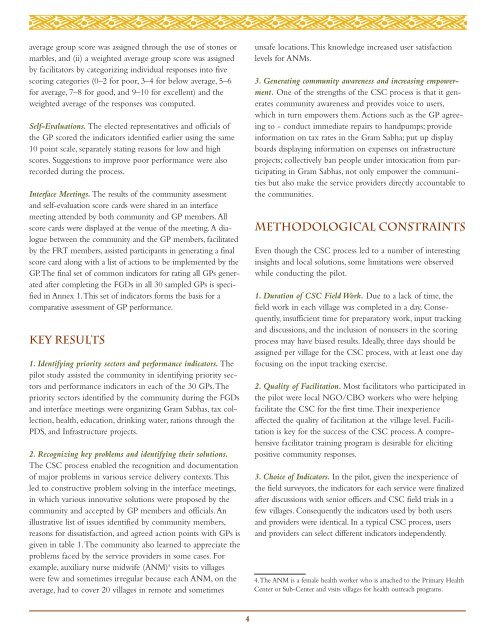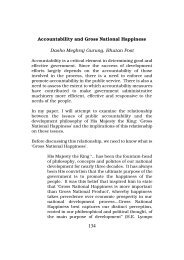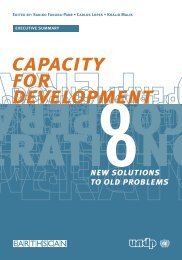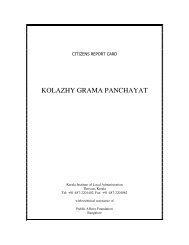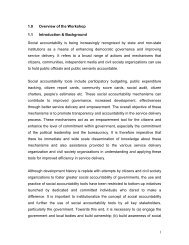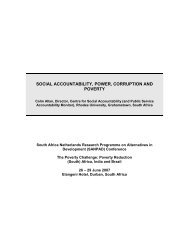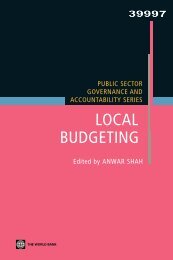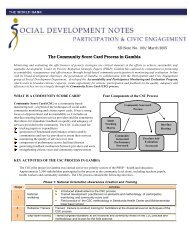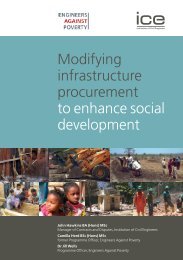Community Score Cards - SASANet
Community Score Cards - SASANet
Community Score Cards - SASANet
- No tags were found...
Create successful ePaper yourself
Turn your PDF publications into a flip-book with our unique Google optimized e-Paper software.
average group score was assigned through the use of stones ormarbles, and (ii) a weighted average group score was assignedby facilitators by categorizing individual responses into fivescoring categories (0–2 for poor, 3–4 for below average, 5–6for average, 7–8 for good, and 9–10 for excellent) and theweighted average of the responses was computed.Self-Evaluations. The elected representatives and officials ofthe GP scored the indicators identified earlier using the same10 point scale, separately stating reasons for low and highscores. Suggestions to improve poor performance were alsorecorded during the process.Interface Meetings. The results of the community assessmentand self-evaluation score cards were shared in an interfacemeeting attended by both community and GP members.Allscore cards were displayed at the venue of the meeting.A dialoguebetween the community and the GP members, facilitatedby the FRT members, assisted participants in generating a finalscore card along with a list of actions to be implemented by theGP.The final set of common indicators for rating all GPs generatedafter completing the FGDs in all 30 sampled GPs is specifiedin Annex 1.This set of indicators forms the basis for acomparative assessment of GP performance.KEY RESULTS1. Identifying priority sectors and performance indicators. Thepilot study assisted the community in identifying priority sectorsand performance indicators in each of the 30 GPs.Thepriority sectors identified by the community during the FGDsand interface meetings were organizing Gram Sabhas, tax collection,health, education, drinking water, rations through thePDS, and Infrastructure projects.2. Recognizing key problems and identifying their solutions.The CSC process enabled the recognition and documentationof major problems in various service delivery contexts.Thisled to constructive problem solving in the interface meetings,in which various innovative solutions were proposed by thecommunity and accepted by GP members and officials. Anillustrative list of issues identified by community members,reasons for dissatisfaction, and agreed action points with GPs isgiven in table 1.The community also learned to appreciate theproblems faced by the service providers in some cases. Forexample, auxiliary nurse midwife (ANM) 4 visits to villageswere few and sometimes irregular because each ANM, on theaverage, had to cover 20 villages in remote and sometimesunsafe locations.This knowledge increased user satisfactionlevels for ANMs.3. Generating community awareness and increasing empowerment.One of the strengths of the CSC process is that it generatescommunity awareness and provides voice to users,which in turn empowers them. Actions such as the GP agreeingto - conduct immediate repairs to handpumps; provideinformation on tax rates in the Gram Sabha; put up displayboards displaying information on expenses on infrastructureprojects; collectively ban people under intoxication from participatingin Gram Sabhas, not only empower the communitiesbut also make the service providers directly accountable tothe communities.METHODOLOGICAL CONSTRAINTSEven though the CSC process led to a number of interestinginsights and local solutions, some limitations were observedwhile conducting the pilot.1. Duration of CSC Field Work. Due to a lack of time, thefield work in each village was completed in a day. Consequently,insufficient time for preparatory work, input trackingand discussions, and the inclusion of nonusers in the scoringprocess may have biased results. Ideally, three days should beassigned per village for the CSC process, with at least one dayfocusing on the input tracking exercise.2. Quality of Facilitation. Most facilitators who participated inthe pilot were local NGO/CBO workers who were helpingfacilitate the CSC for the first time.Their inexperienceaffected the quality of facilitation at the village level. Facilitationis key for the success of the CSC process. A comprehensivefacilitator training program is desirable for elicitingpositive community responses.3. Choice of Indicators. In the pilot, given the inexperience ofthe field surveyors, the indicators for each service were finalizedafter discussions with senior officers and CSC field trials in afew villages. Consequently the indicators used by both usersand providers were identical. In a typical CSC process, usersand providers can select different indicators independently.4.The ANM is a female health worker who is attached to the Primary HealthCenter or Sub-Center and visits villages for health outreach programs.4


